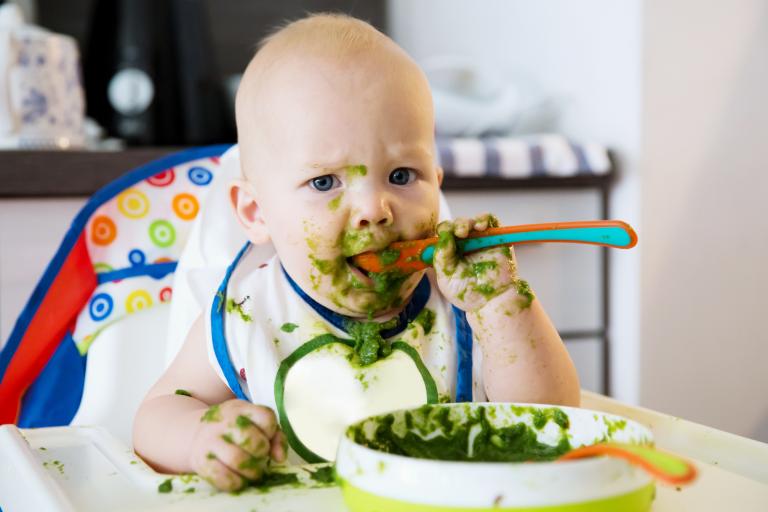Happy. Healthy. Southie.
Supportive and non-judgmental advice from SBCHC's health experts.
Starting Solids Primer: Part 2
By: Jocelyn Guggenheim
This is part two of our Starting Solids Primer. In part one we discussed when to start solids. Click here to start there.
So you’ve determined your baby and you are both ready for them to start solids, and now you are wondering what exactly to do first.
There are two common feeding styles you’ve likely heard of: parent led feeding of purees and baby led weaning. The latter has become more common in the last 10 years. Weaning in this case refers to the idea that any introduction of solids means the baby is being weaned from breast milk or formula but does not involve actively reducing the infant’s breast milk or formula intake.
What are they and how are they different?
With feeding of purees parents offer pureed or liquid foods on a spoon to a baby, watching their cues for when they are interested and when they are done. This would be what you’re doing whenever you give jarred food or feed a baby something with a spoon you control.
This method has lots of advantages:
It is easy to tailor the nutrition and flavor of meals because anything can be pureed.
Babies can’t choke and don’t usually gag because the food is liquid and so any food that doesn’t get swallowed just gets drooled out.
It is easy to slowly increase the texture of the food and the components of the food as babies get better at eating and their digestive tract adjusts to digesting solids, so components of food can be controlled throughout the solid introduction process.
There may be disadvantages for some families:
Some babies don’t like being fed or don’t find purees interesting. They may grab the spoon (insisting they will feed themselves) and paint their face with the food but ingest very little and not enjoy having someone else offer them food.
Most adults do not eat purees more than an occasional smoothie so there is another transition that happens when babies go from pureed food to finger foods (or pieces of food that have not been pureed).
Some worry that babies are learning to swallow before they learn to bite or chew. It’s not clear if this is a problem for children but advocates of baby led weaning note it is not the way older children and adults eat.
Baby led weaning refers to offering babies pieces of food that are safe for them to bite, chew and swallow but that are not pureed (unless the child spoon feeds the puree on their own).
This typically starts with foods that are very soft (specifically soft enough to squish between your two fingers) and are shaped so babies can pick them up themselves (think about a French fry or spear shape).
The advantages of baby led weaning are:
Babies are in charge of what they eat and learn to decide how much to eat from the start because they only get food if they put it in their own mouths.
Families typically offer food they are eating anyway so there may be less meal prep.
When children enjoy this method of feeding they quickly transition to meals with families, which is our ultimate goal for all children, avoiding the “kids food” that is typically bland, salty, and usually not very healthy.
There are some important disadvantages to be aware of:
Most children will gag when they do baby led weaning, at least at first. Gagging and choking are not the same thing. Gagging is loud and may make a child vomit but is not dangerous. Choking is silent and is an emergency because the child’s airway is completely blocked. Choking is not common with baby led weaning but is certainly something parents need to be vigilant for. I recommend any parent who is using baby led weaning take a CPR and infant choking class to know what to do if this occurs.
Nutrition can be more challenging with baby led weaning. It is important not to give young children too much salt or sugar and adults often eat heavily salted or sweetened foods so parents need to be cognizant of not just giving babies food they are eating if they are not healthy (my favorite example is fried takeout, this is not appropriate for baby led weaning).
It is also harder to systematically expose young children to a variety of foods with this method. Pureeing food means you can expose a child to anything that can be put in a blender. Foods that are crunchy or sticky or soup-like and need to be spoon-fed (which is done only by the baby in baby led weaning) may take months for children to be able to eat themselves.
My opinion is that a combination of approaches may be more appropriate for many families but that for many others one will make more sense than the other. The most important thing is to know yourself and your baby and consider changing course if the method you thought you wanted to use isn’t working for you or your baby.
Either way children should always be sitting in a supportive infant feeding chair when they eat solids. The people around them should be attentive to the baby and it should be a pleasant experience so the social aspects of feeding are taught early.
As for best first foods to feed:
We recommend starting with veggies and fruits. Infant cereals are becoming less common as a first food as they have limited nutrition. If you do feed cereals look for ones that are oatmeal or multigrain instead of rice cereal (which can be constipating). Also look for iron fortified infant cereal. Iron is an important part of infant diets starting at 6 months old so we encourage iron rich foods from the start. This certainly can mean dark meats but vegetarian children can get plenty of iron from iron fortified cereals, dark leafy vegetables, raisins and prunes.
For children who have no family history of allergies:
There is a growing body of evidence that shows that early introduction of allergy producing foods reduces the risk of children developing allergies. Practically this means that in the first month of feeding solids children should be given small amounts of foods that cause allergies. These include peanuts, tree nuts, dairy, eggs, soy, shellfish, berries and citrus.
With any of these foods you want to ensure the allergenic food is not given at the same time as another new food so any reaction can be isolated to the correct food. The new allergenic food should be given in the morning and once a day for 3-5 days before another new food is given. Once kids are eating this food without difficulty it should remain part of their diet. Check with your child’s PCP if there are any diet restrictions for your baby.
The only food that all children should avoid, cooked or raw, under all circumstances is honey (because of a risk of botulism, which is rare but potentially fatal).
Stay tuned for part 3 with specific ideas for early meals whether you’re doing baby leg weaning, puree feeding or both!

